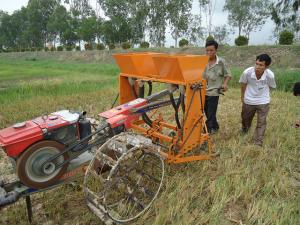|
|
May 19, 2011 -- The first no-tillage seed drill built by a local Cambodian equipment manufacturer successfully passed its field test at the Cambodian Agricultural Research & Development Institute (CARDI) at Prateah Lang Commune, Dangkor, outside Phnom Penh this week.
The seed drill is one of 11 being built by agricultural equipment manufacturer Mr Ouchhoeun Larano at Russeykeo, Phnom Penh. Six of the machines were commissioned by ACIAR as part of a project that is helping Cambodia to diversify and intensify cropping in rainfed lowland areas.
“No-till seed drills allow farmers to plant their crops without ploughing, saving them fuel costs, preserving soil moisture and reducing soil erosion,” said Professor Bob Martin who helped CARDI trial the technology that is now widely used by Australian farmers.
Prototype testing
A prototype tyned seed drill, developed by Mr Jeff Esdaile in an earlier ACIAR project, was delivered to CARDI in 2008. It is simple, light weight and can be adjusted for other uses such as inter-row cultivation, land levelling, bed shaping, or as a boom spray.
Field trials of the prototype no-till seed drill in Kampong Thom, Takeo, Kampot and Kampong Speu provinces by Mr Som Bunna and the agricultural engineers at CARDI found that fields planted with the drill provided the best crop establishment for tilled paddy field.
“We found some technical issues with slow mungbean growth after no-till planting in lowland paddies after rice harvesting, despite good establishment, but this may have been due to the compacted and poorly drained soils such as the Prateah Lang, ,” said Mr Som Bunna. “In this situation we recommend making beds for the mungbean, forming ridges and furrows to minimize these problems, and to facilitate furrow irrigation.”
Further research
“There is still more work to do with regard to the best options for bed shaping as well as adapting the seed drill to different soil types and farming systems in other provinces,” Mr Som Bunna said. The six new seed drills commissioned by ACIAR will be distributed to projects in various provinces for further research evaluation.
Mr Larano said that Cambodian farmers are already lining up to buy the other five seed drills that are being built for a cost of US$1,300 each. It is expected the no-till machines could be mass produced at very affordable prices for Cambodian farmers.







Post a comment
Report Abusive Comment